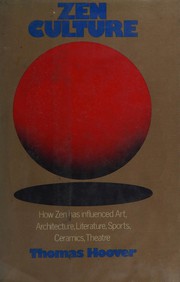Check nearby libraries
Buy this book

Zen Culture
(Random House, 1977)
Anyone who examines the Zen arts is immediately struck by how modern they seem. The ceramics of 16th-century Zen artists could be interchanged with the rugged pots of our own contemporary crafts movement; ancient calligraphies suggest the monochromes of Franz Kline or Willem de Kooning; the apparent nonsense and illogic of Zen parables (and No theater and Haiku poetry) established the limitations of language long before the theater of the absurd; 400-year-old Zen architecture seems to be a copy of modern design ideas such as modular sizing, exposed woods, raw materials, bare walls, uncluttered space and a California marriage of house and garden.
Zen values experiencing things over analyzing them. Perhaps if we can take the power of direct perception, sharpened by the devices of Zen art, back to everyday activities, we will find a beauty in common objects that we previously ignored.
Selected Reviews
The notoriously grumpy Kirkus Reviews said, “Thomas Hoover has a considerable gift for expressing his appreciation and understanding of various arts associated with Zen. . . . These are deftly treated, with a concise synopsis of the historical development of each; and together Hoover’s discussions provide an excellent introduction to the aesthetics of Japanese culture.”
Library Journal said, “Hoover covers the ground in an easy and informative way, describing the origins of Zen itself and the Zen roots of swordsmanship, architecture, food, poetry, drama, ceramics, and many other areas of Japanese life. The book is packed with facts, the bibliography is excellent, the illustrations few but most appropriate, and the style clear and smooth. A most useful book for all collections.”
Asian Studies declared, “Highly recommended. ZEN CULTURE moves easily from the political climate that gave rise to Zen to the cultural areas – art, architecture, theatre, literature, flower arrangement, design, archery, swordsmanship – where Zen has manifested itself.”
As for the influence of the Zen aesthetic, the Houston Chronicle said, “Hoover suggests we need only look around. Modern furniture is clean, simple lines in unstained, unadorned woods. And that old fad became a habit, houseplants. These are all expressions of ideas born with Zen: understatement, asymmetry, intuitive perception, nature worship, disciplined reserve.”
“Highly recommended,” said The Center for Asian Studies.
“Western intellectuals have tried to represent the height of Buddhist mysticism within the pages of mere books, reducing an ineffable experience into a written report. Predictably such attempts have failed miserably. ZEN CULTURE by Thomas Hoover comes the closest to succeeding,” said Hark Publishing.
“ZEN CULTURE, concerned as it is with the process of perception as much as with actual works of art, can open our sense so that we experience anew the arts of both East and West, ancient and modern.” declared the Asian Mail.
And to go multi-media, NYC-FM in New York said, “Hoover takes us on a grand tour of Zen archery and swordsmanship, flower arranging, drama, food, gardening, painting, poetry, architecture. His book is essentially one by a connoisseur.”
Idea points: Zen History, Haiku, Zen, Ceramics, Archery, Landscape Garden, Stone Garden, Ink Landscape, Zen Architecture, Sword, Katana, No Theater, Noh Theater, Japanese Tea Ceremony, Flower arranging, Ikebana, Zen Ceramic Art, Raku, Shino, Ryoanji-ji
Check nearby libraries
Buy this book

Previews available in: English
Showing 6 featured editions. View all 6 editions?
| Edition | Availability |
|---|---|
| 1 |
zzzz
Libraries near you:
WorldCat
|
| 2 |
cccc
Libraries near you:
WorldCat
|
| 3 |
zzzz
Libraries near you:
WorldCat
|
| 4 |
zzzz
|
|
5
Zen culture: How Zen has influenced Art, Architecure, LIterature, Sports, Ceramics, Theatre
1977, Random House
Hardback (Digital FREE at www.thomashoover.info)
in English
- 1st ed.
0394410726 9780394410722
|
cccc
Libraries near you:
WorldCat
|
|
6
Zen culture: How Zen has influenced Art, Architecture, Literature, Sports
1977, Random House
Read Free at www.thomashoover.info
in English
- 1st ed.
0394410726 9780394410722
|
aaaa
Libraries near you:
WorldCat
|
Book Details
Published in
New York
Edition Notes
Bibliography: p. [235]-244.
Includes index.
Classifications
The Physical Object
ID Numbers
Work Description
(New American Library,1980)
Library Journal called it, “The best history of Zen ever written.”
The truth of Zen has always resided in individual experience rather than in theoretical writings. To give the modern reader access to understanding of this truth, THE ZEN EXPERIENCE illumines Zen as it was created and shaped by the personalities, perceptions, and actions of its masters over the centuries.
Beginning with the twin roots of Zen in Indian Buddhism and Chinese Taoism, we follow it through its initial flowering in China under the First Patriarch Bodhidharma; its division into schools of “gradual” and “sudden” enlightenment under Shen-hsui and Shen-hui; the ushering in of its golden age by Hui-neng; the development of “shock” enlightenment by Ma-tsu; its poetic greatness in the person of Han-shan; the perfection of the use of the koan by Ta-hui; the migration of Zen to Japan and its extraordinary growth there under a succession of towering Japanese spiritual leaders.
Rich in historical background, vivid in revealing anecdote and memorable quotation, this long-needed work succeeds admirably in taking Zen from the library shelves and restoring its living, human form.
(Free digital copies at www.thomashoover.info, Google Books, B&N, Amazon, Smashwords, Gutenberg)
Community Reviews (0)
Feedback?| September 16, 2021 | Edited by ImportBot | import existing book |
| February 20, 2021 | Edited by ImportBot | import existing book |
| November 17, 2018 | Edited by MARC Bot | import existing book |
| December 15, 2010 | Edited by Thomas Hoover | Edited without comment. |
| December 10, 2009 | Created by WorkBot | add works page |











